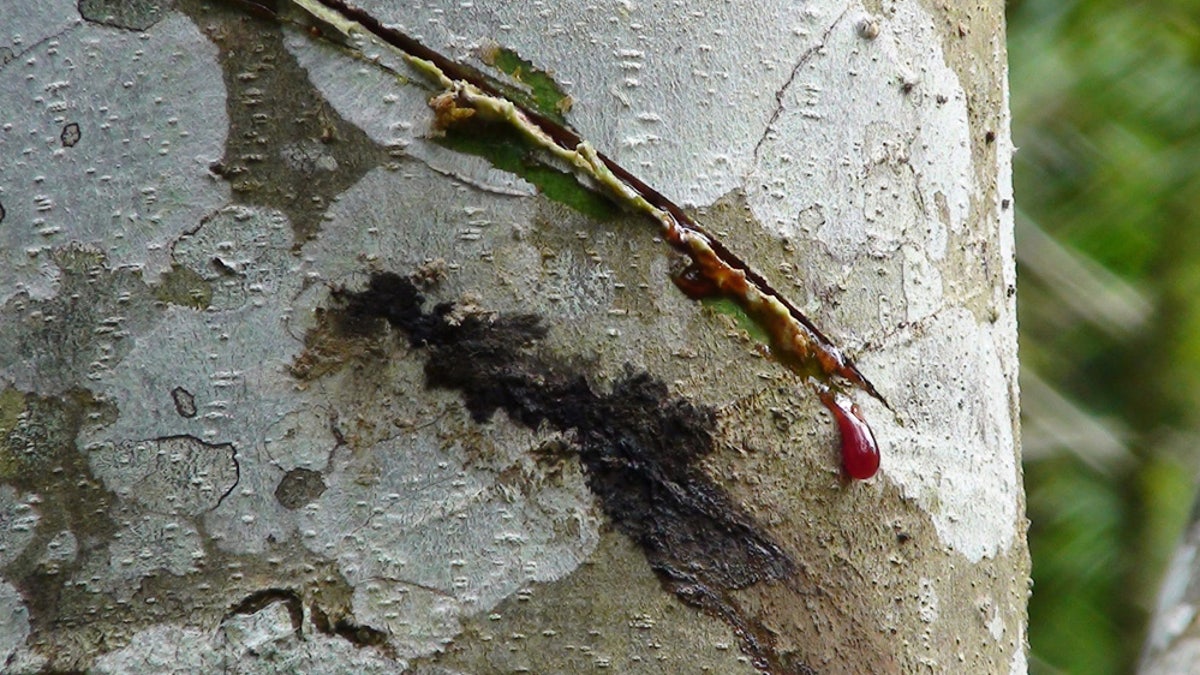
By the side of a rutted, muddy road up the Rio Aguaytia in the Peruvian Amazon, my friends and I stopped to admire a stand of Croton lechleri – Dragon’s blood trees. The tall trees bore a mottled-white and gray bark, and a couple of the trees also featured diagonal slashes. They had been previously cut into with a machete’ to yield the resinous sap for which the tree is deservedly famous.
Dragon’s blood, they call the sap, which runs from the diagonal slashes in the same manner that rubber runs from rubber trees. But while the latex of rubber is white, Dragon’s blood runs rich and red, just like fresh blood.
Throughout much of the Amazon rainforest, Dragon’s blood, called both Sangre de Drago and Sangre de Grado, is the primary topical aid for just about anything bad that can happen to skin. Cuts, bites, burns, stings, rashes, abrasions, sores, and wounds and skin insults of all kinds benefit from application of the healing red latex of this tree.
Dragon’s blood contains a broad range of naturally-occurring compounds, many of which have been well studied. The sap is rich in protective antioxidant phenols, and anti-inflammatory compounds of various kinds. Due to these compounds, Dragon’s blood sap helps to protect the cells of the skin, and reduces redness and swelling. It also contains a group of compounds called proanthocyanidins, which actually repair collagen, the lattice-like main protein that makes up much of our tissues. Additionally, Dragon’s blood contains taspine, a known tissue-healing agent. The sap also demonstrates antibacterial, antiviral and antifungal activity. This is why Dragon’s blood is so widely used on infectious skin conditions of all kinds with great success.
Making the cut – to obtain Dragon’s blood – it is necessary to cut into the bark of the tree at a diagonal, deeply enough that the blood-like sap will flow. A cup is affixed to the tree at the bottom end of the slash, and the sap collects in the cup. In the markets of the Amazon, you will find bottles of Dragon’s blood selling at various medicinal stands, and at many other types of shops. As indispensable a home first aid agent as bandages, Dragon’s blood is liberally applied to the skin in case of a problem. When the red sap is rubbed onto skin, it forms a thin cream-colored layer, like a very fine additional skin membrane. I have used Dragon’s blood many times myself, and have cut trees to obtain the sap, especially in cases of bad bites and stings. In almost all cases, Dragon’s blood is collected in small quantities, one or two litres at a time.
Now, a whole new application of Dragon’s blood sap might change the scale of sap collection, and may contribute to greater economic benefit for native people who live in areas where the tree flourishes. This new application is in cosmetics. After decades of good science has been churned out about this remarkable skin-enhancing agent, cosmetic companies are starting to include Dragon’s blood sap in skin elixirs, creams, and other special preparations. Most of the time, cosmetic companies want ingredients that are pure white, to maintain whiteness of creams and lotions. But Dragon’s blood turns the same preparations pink, and so a new color of skin agent will be showing up on cosmetic shelves.
Plant materials often start out in one place in the world and then spread far and wide. Lemongrass grown in Thailand can wind up flavoring dishes in London. Turmeric root from Indonesia can wind up in curry in Chicago. And Dragon’s blood sap from the Peruvian Amazon rainforest can wind up in cosmetic lotions and creams on the shelves of department stores around the globe.
If the sap of Dragon’s blood is harvested sustainably, and if the sap is used in an amount sufficient enough to legitimately benefit skin, and if the people who do the hard work of tapping Dragon’s blood trees in the Amazon can earn a decent wage, then everybody in the system benefits. We have in Dragon’s blood sap a remarkable healing agent that totally exceeds in benefit to the skin any synthetic ingredient. This is just one example of how rainforest products can help to keep some acreage intact due to the economic benefits of sustainable harvesting. Instead of cutting down the forest for timber, the forest can be better intact, and can yield greater profits through trade in medicinal plants, fruits, and oil-bearing nuts and seeds. And with Dragon’s blood, you also derive an even more elusive and sought-after effect – enhanced beauty.
Where to obtain Dragon’s blood? If you want some pure Dragon’s blood to try for yourself, a source I recommend is Raintree Nutrition at www.rain-tree.com. A bottle of Dragon’s blood in the medicine chest provides ready ammunition in the fight against skin troubles.
Chris Kilham is a medicine hunter who researches natural remedies all over the world, from the Amazon to Siberia. He teaches ethnobotany at the University of Massachusetts Amherst, where he is Explorer In Residence. Chris advises herbal, cosmetic and pharmaceutical companies and is a regular guest on radio and TV programs worldwide. His field research is largely sponsored by Naturex of Avignon, France. Read more at www.MedicineHunter.com
Follow us on twitter.com/foxnewslatino
Like us at facebook.com/foxnewslatino
